First World War Project
Arthur Harold HUGHES (of Lynsted with Kingsdown)
b. 21st April 1885 Leading Stoker, Service Number K/1134 |
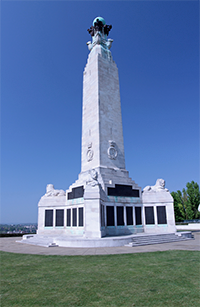
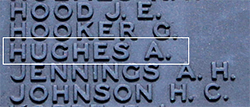
Born Arthur Harold "Knight" in Chatham on 21 April 1885, Arthur was the adopted son of Henry, a yeoman labourer, and Mary Ann Hughes. The 1891 Census records show Arthur living at Fulston House in Bell Road, Sittingbourne along with another adoptee, Florence M Gilham, and his father's brother Edward.
By the time of the 1901 census Arthur had moved with his adoptive parents to Bapchild Street, Bapchild, and was working with Henry as an agricultural labourer. His adopted sister, Florence, had married William England in Lynsted Church on Christmas Day 1897. Arthur was still using his birth name of Knight but was now recorded as a boarder rather than an adopted son.
The 1911 Census finds Arthur in the Royal Navy under his adoptive name of Hughes. He was serving on the First Class Armoured Cruiser, HMS Lancaster, under Commander Hugh Tothill, moored off Malta.
Arthur had left his job as a brickfield labourer and enlisted in the Royal Navy on 17 August 1908 for 12 years. All his naval records, apart from the record of his death, list his date of birth as 1887 rather than 1885, and his place of birth as Sittingbourne. He saw service on HMS Acheron, Sapphire, Hawke, Lancaster, Albion and Goliath.
On 22 December 1913, Arthur married Kate Kirby in Lynsted Church. Kate was working as housekeeper to the Headmaster of Lynsted School, Mr Ackermann, and was living in the School House. Kate and Arthur took up residence in Oak Cottages, Ludgate Lane.
At the outbreak of war, Arthur was serving on HMS Mars. On 1 February 1915, he was transferred to HMS Pembroke (the Chatham land base). This coincided with the birth of his daughter, Winifred Edith.
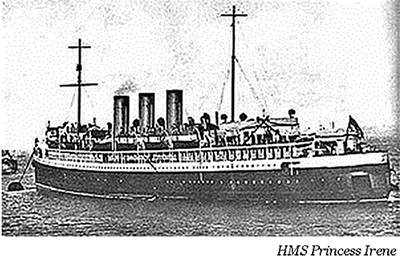 On 27 May 1915, Arthur was working on the HMS Princess Irene following her requisition and conversion to an auxiliary minelayer. She had originally been built for the Canadian Pacific Railway Company and launched on 20 October 1914. She now served out of Sheerness dockyard.
On 27 May 1915, Arthur was working on the HMS Princess Irene following her requisition and conversion to an auxiliary minelayer. She had originally been built for the Canadian Pacific Railway Company and launched on 20 October 1914. She now served out of Sheerness dockyard.
The Princess Irene was moored on No.28 buoy, off Port Victoria Pier in Salt Pan Reach, off Sheerness, where she was being loaded with 500 proximity mines for her first mine-laying mission planned for 29 May. On board were all but three of the ship's full complement and 77 Dockyard workers.
At 11.14am, HMS Princess Irene exploded and disintegrated. Eye witness reports say a column of flame leapt 300 feet high, followed a few seconds later by another explosion. A pall of smoke then hung over the spot where the Princess Irene had been, reaching to 1,200 feet. In total, 352 people were killed; all the ship's company and all but one of the dockyard workers perished. In addition, a girl of nine was killed by flying debris on the Isle of Grain, and a farmhand died of shock. A man working on another ship died from injuries sustained when he was struck by a piece of the Princess Irene's boiler weighing 70 pounds. The lone survivor of the explosion was dockyard worker, David Percy Wills, who escaped with severe burns.
The devastation went further afield. A colliery half a mile away had its crane blown off its mountings. It was reported that people in Sittingbourne and Bredhurst were injured by flying debris and, somewhat gruesomely and possibly apocryphally, there were reports of severed heads landing in Hartlip and the Isle of Grain. A case of butter landed at Rainham and was swiftly looted. A 10-ton section of the ship landed on the Isle of Grain, damaging the Admiralty's oil storage tanks. Wreckage was reported landing in a radius of 20 miles.
Unsurprisingly, only 10 bodies were recovered from the Princess Irene and they are buried at Woodlands Road Cemetery, Gillingham, alongside the remains of those killed on the HMS Bulwark, which exploded just 6 months earlier on 26 November 1914. Sadly, Arthur's body was not found but his wife would certainly have heard and felt the explosion from her home just a few miles away in Lynsted.
On 1 June 1915, a memorial service for the victims was held at the Dockyard Church, Sheerness, led by the Archbishop of Canterbury, Randall Davidson.
In the aftermath, an inquest was convened on just two victims of the disaster and it was agreed that the coroner would not hold additional inquests unless exceptional circumstances warranted it.
| The day after the explosion, a Court of Enquiry was held at the Royal Naval Barracks in Chatham. Evidence was given that priming of the mines was being carried out hurriedly and by untrained personnel. Ratings from the HMS Angora were called to explain to the Court how these mines were primed. Extracts from the minutes are as follows: |
| "In the ship that I am in, the Chief Electrical Artificer and the Chief Armourer cock the pistol and examine it. After that is done it is passed to the Torpedo Gunner's Mate - one Torpedo Gunner's Mate to each pair of mine rails. The priming party is stationed at a table between the mine rails, these men fitting the detonators into the primers. The fitted primer is then passed to the Torpedo Gunner's Mate who fixes it on the pistol, examining the pistol before fitting the primer. This is the routine carried out when we have time to do it, but as a rule, the thing is done at such a rush that you have to employ other people on the work in addition to the Torpedo Gunner's Mates……... Leading Torpedo Men and Seamen Torpedo Men." The question was asked whether these men have been given training on this procedure: "Instruction is given in the ship. There is also another point I should like to mention in regard to the priming. The priming is practically the last thing done after the mines are got on board and the men have practically worked 18 hours out of 24 and when it comes to the priming they have just about had enough of it. Therefore unless you have got proper experienced people to do the work - Petty Officers that you can trust - you cannot guarantee that the proper amount of care is going to be taken for the work." The outcome of the Court of Inquiry was as follows: In compliance with your Memorandum No. W.24.G. of the 27th May, 1915, we have the honour to report that, having held a careful enquiry into the circumstances attending the blowing up of H.M.S. "PRINCESS IRENE", the Court is of the opinion that the explosion was an accidental one. The evidence shows that at the time of the accident mines were being primed on board. The form of pistol used has been shown and explained to the Court and it appears that a premature explosion might be caused by faulty construction of a pistol if the striker projected into the primer holder so that it could penetrate the detonator when the primer was being screwed on. A faulty pistol in which the striker projected more than one-sixteenth of an inch as supplied to H.M.S. "ANGORA" was produced to the Court. A second possible cause of explosion might be if when fitting a pistol the tumbler levers did not properly engage under the dropper ring; it has been shown that they will hold with only one under or with all three bearing against but not under the dropper ring. In such a case, if the pistol were being fitted into the mine, any jar might release the striker and explode the detonator. A third possible cause of explosion would be if the India rubber washer was left out of the top of the primer leaving the detonator free to be thrown against the striker, but this could only occur if the striker projected too far as in the first case. The Officers, Petty Officers and men who gave in written statements were all questioned as to whether they had anything to add to their statements. Under the lamentable circumstances, the Court consider it impossible to attribute blame but is of the opinion that no plea of haste should ever allow for these pistols being fitted by other than fully qualified men and further that a slight mechanical device should be fitted to the pistols to ensure that the pistol could not fire until it is properly placed with the other safety devices in the mine. Our report is accompanied by the minutes of evidence. The inquiry has been hurried to permit Commander Petre proceeding to sea, but it is not thought that any additional evidence of value is likely to be obtained. We have the honour to be, Sir, Your obedient Servants, Commander. H.M.S. "ANGORA" Captain. H.M.S. "CONQUEST" Rear Admiral. H.M.S. "PEMBROKE". |
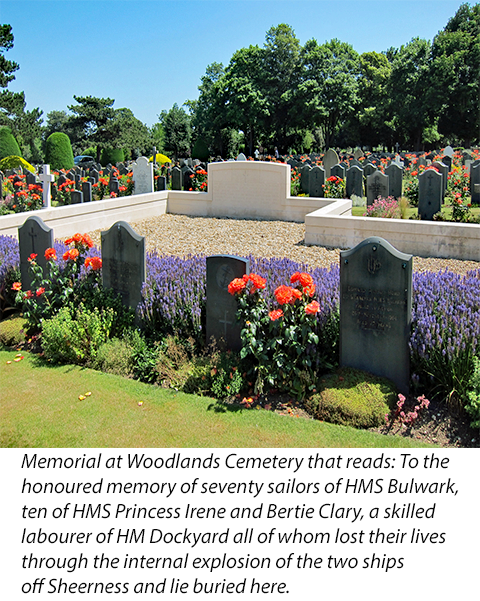 Following the loss of HMS Natal on 30 December 1915 and HMS Vanguard on 9 July 1917, and previously the loss of HMS Bulwark and HMS Princess Irene, all caused by internal explosions, suspicion was raised that sabotage was to blame for the loss of all four ships. A worker at Chatham Dockyard was named as a suspect but an investigation by Special Branch cleared him of any blame.
Following the loss of HMS Natal on 30 December 1915 and HMS Vanguard on 9 July 1917, and previously the loss of HMS Bulwark and HMS Princess Irene, all caused by internal explosions, suspicion was raised that sabotage was to blame for the loss of all four ships. A worker at Chatham Dockyard was named as a suspect but an investigation by Special Branch cleared him of any blame.
A memorial to those lost on Bulwark and Princess Irene was erected at the Dockyard Church, Sheerness, in 1921. It was unveiled by Hugh Evan-Thomas, Commander-in-Chief, The Nore (this post was an operational command of the Royal Navy, the Nore being a sandbank at the mouth of the River Medway) and dedicated by Archdeacon Ingles, the Chaplain of the Fleet. Victims of both ships are also commemorated at a memorial in Woodlands Road Cemetery, Gillingham, as part of the Naval Burial Ground.
Arthur is also remembered in the Chatham Naval Memorial book and in the Faversham Armistice Memorial Service Programme. He was posthumously awarded the 1914-15 Star and the British War and Victory medals. [See Appendix 1]
He is commemorated on the Chatham Naval Memorial. Panel 11. (See the top of this page)
| Two years after his death his wife placed the following in the 26 May 1917 issue of the East Kent Gazette: |
| HUGHES – IN MEMORIAM No useless coffin covered his breast, |
Sadly, the wreck of the Princess Irene was not declared a war grave. In fact, the wreck was "lost" until 1962 when a tug fouled on it. Some 25 tons of wreckage above the sea bed were removed between 1962-64. The lower hull still remains in position.
Arthur's wife, Kate, never remarried and died on 8 October 1953.
In December 1987, Arthur's daughter, Winifred (Head), who was then living in Faversham, wrote to David Bage, the then editor of the Kingsdown and Lynsted Parish Newsletter. She asked whether her childhood home - which she referred to as "the old house" - had survived the October "hurricane". By the description of the property, and the fact that Winifred remembered that a Mrs Chapman took up residence when she and her mother moved out, David Bage was able to confirm that the house to which she referred was one of the "Oak Cottages". It had indeed survived the storm. It was obvious that, despite losing her father, she recalled happy times in Oak Cottages. So much so that she wrote this poem published in the Parish newsletter:
The Old House
The old house stands there just the same,
The beams, the porch, the window frame.
In far off days they said "it's old"
Yet still it stand there just as bold.
I see the shadows of the past,
It's sad to think they could not last.
My mother with her pleasant face,
Always busy around the place.
The pigeons on the sloping tiles,
Since then I've travelled many miles.
I'd like to go back to those days
When people had such gentle ways,
Blowing bubbles in the air,
The old cat sleeping on the chair.
I'm sure these shadows still remain,
I visualise them all again.
The old house looks so lonely there,
Does it have a thought or prayer?
It's lovely now to pass that way,
Restores the happiness for just one day.
Extract from The Times - 31st May 1915 listing Arthur Hughes as being killed in The Princess Irene.
References suggest this list was pinned outside Sheerness Harbour.
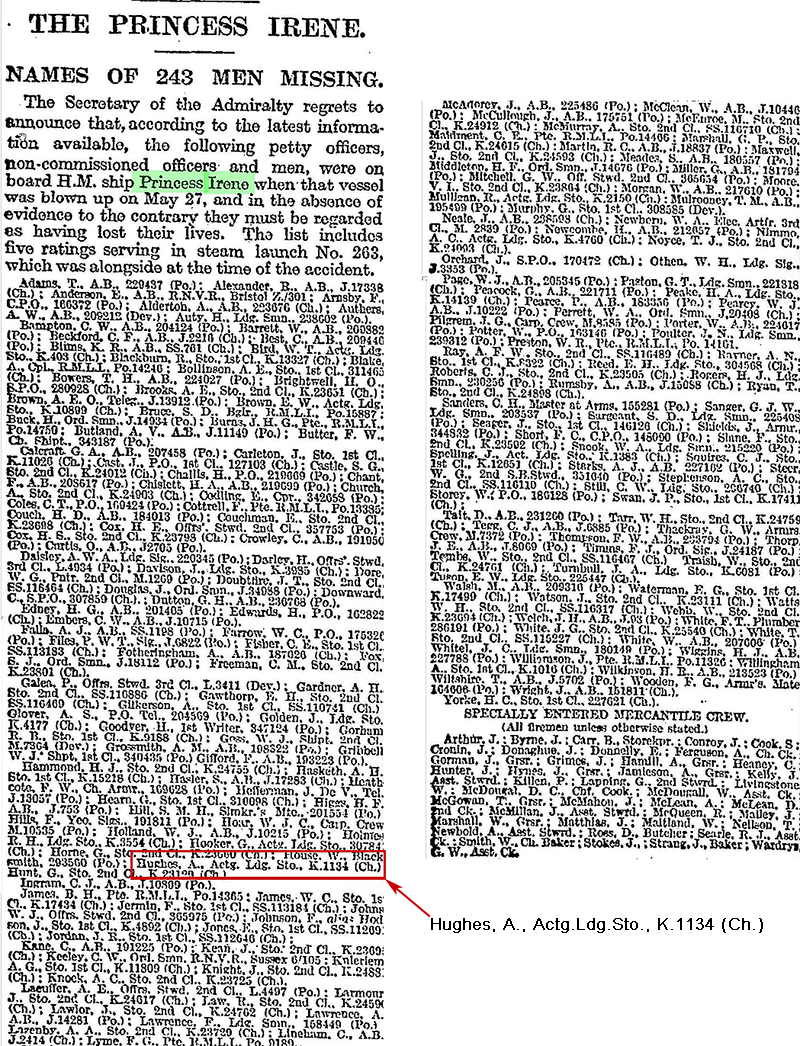

 World War 1 Pages
World War 1 Pages